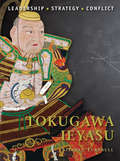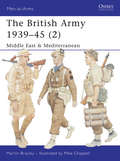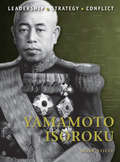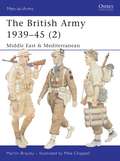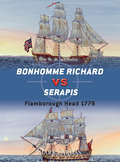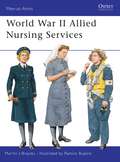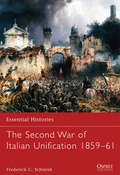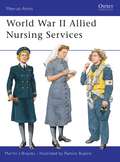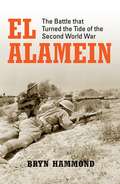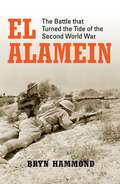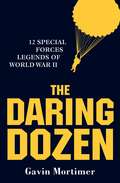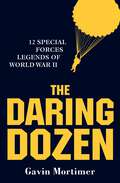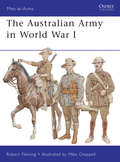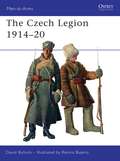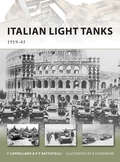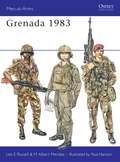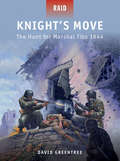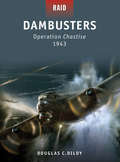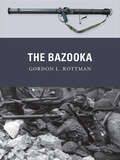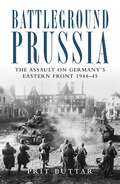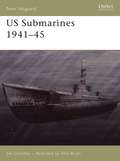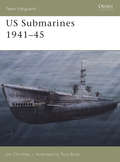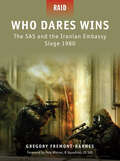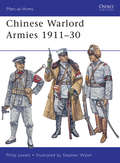- Table View
- List View
Tokugawa Ieyasu: The Life Of Tokugawa Ieyasu (Command)
by Giuseppe Rava Dr Stephen TurnbullTowards the end of the 16th century three outstanding commanders brought Japan's century of civil wars to an end, but it was Tokugawa Leyasu who was to ensure a lasting peace. In terms of his strategic and political achievements Leyasu ranks as Japan's greatest samurai commander. Leyasu possessed the rare wisdom of knowing who should be an ally and who was an enemy, a key skill for a successful military leader. Leyasu's crowning victory at Sekigahara depended on the defection to his side of Kobayakawa Hideaki, and the absence from the scene of Ieyasu's son Hidetada serves to illustrate how just once there was a failure in Ieyasu's otherwise classic strategic vision. To establish his family as the ruling clan in Japan for the next two and a half centuries was abundant proof of his true greatness.
The British Army 1939–45: Middle East & Mediterranean (Men-at-Arms #368)
by Mike Chappell Martin BrayleyThe scope of Britain's wartime Middle East Command stretched far beyond the Libyan desert where the 8th Army's most famous battles were fought from Gibraltar and Tunisia in the west, to Iraq and Persia in the east, and from Greece south to the Gulf of Aden. In 1940-43 this was the only arena where the British Army could take the ground war to the German Wehrmacht; it saw a succession of setbacks and triumphs, until spring 1945 found the 8th Army victorious in northern Italy. A summary of these campaigns is illustrated by photographs, and detailed colour plates of the wide range of uniforms worn in the varied conditions of this huge theatre of war.
Yamamoto Isoroku (Command #26)
by Mark Stille Mr Adam HookAdmiral Yamamoto Isoroku was the defining Japanese naval commander of World War II. Yamamoto's career in the Imperial Japanese Navy started in the early years of the 20th century and he saw service in the Russo–Japanese War, being wounded in the battle of Tsushima in 1904. He went on to study at Harvard University and serve as a naval attaché in the inter-war years, an experience that was to give him a unique insight into the American psyche. Despite the success of his daring pre-emptive strike on Pearl Harbor in 1941, that damaged the US Pacific Fleet and ushered in the Pacific War, Yamamoto's subsequent handling of the Japanese combined fleet can be called into question. The final campaign commanded by Yamamoto was that around Guadalcanal, where Yamamoto's myth of excellence will be totally laid bare. Despite a considerable numerical advantage over the Americans, Yamamoto never brought this advantage to bear. The result was a devastating defeat for the Imperial Japanese Navy and, eventually, the death of Yamamoto himself.
The British Army 1939–45: Middle East & Mediterranean (Men-at-Arms)
by Mike Chappell Martin BrayleyThe scope of Britain's wartime Middle East Command stretched far beyond the Libyan desert where the 8th Army's most famous battles were fought from Gibraltar and Tunisia in the west, to Iraq and Persia in the east, and from Greece south to the Gulf of Aden. In 1940-43 this was the only arena where the British Army could take the ground war to the German Wehrmacht; it saw a succession of setbacks and triumphs, until spring 1945 found the 8th Army victorious in northern Italy. A summary of these campaigns is illustrated by photographs, and detailed colour plates of the wide range of uniforms worn in the varied conditions of this huge theatre of war.
Bonhomme Richard vs Serapis: Flamborough Head 1779 (Duel #44)
by Peter Bull Giuseppe Rava Mark LardasThe clash between the American Bonhomme Richard and the British HMS Serapis during the American Revolutionary War is perhaps the most famous single-ship duel in history. This epic battle between two very similar ships – and crews – off the coast of Britain in September 1779 created two naval heroes: in victory, John Paul Jones became a figure that all future American naval officers would aspire to emulate, while Richard Pearson, in defeat, became a hero to the British for a tenacious defence that allowed the merchant vessels under his protection to escape. Featuring specially commissioned full-color artwork, this is the story of an epic maritime clash at the height of the Revolutionary War that provided a founding legend for generations of US naval officers and demonstrated the intrepidity and fighting prowess of the fledgling US Navy.
World War II Allied Nursing Services (Men-at-Arms #370)
by Ramiro Bujeiro Martin BrayleyThe skill and care of the women of the Allied military nursing services was remembered gratefully by hundreds of thousands of wounded servicemen. The small peacetime services increased rapidly by enrolling reservists and volunteers; the great majority of the nurses who cared for Allied casualties were 'civilians in uniform', who worked tirelessly under difficult conditions and in tented hospitals close to the front lines in real danger; many nurses paid for their devotion with their lives. This first-ever fully illustrated study of the US, British, Commonwealth, and other nursing organisations includes many unpublished photographs and 24 meticulously illustrated colour figures.
The Second War of Italian Unification 1859–61 (Essential Histories #74)
by Frederick C. SchneidThe culmination of decades of nationalist aspiration and cynical Realpolitik, the Second War of Italian Unification saw Italy transformed from a patchwork of minor states dominated by the Habsburg Austrians into a unified kingdom under the Piedmontese House of Savoy. Unlike many existing accounts, which approach the events of 1859–61 from a predominantly French perspective, this study draws upon a huge breadth of sources to examine the conflict as a critical event in Italian history. A concise explanation of the origins of the war is followed by a wide-ranging survey of the forces deployed and the nature and course of the fighting – on land and at sea – and the consequences for those involved are investigated. This is a groundbreaking study of a conflict that was of critical significance not only for Italian history but also for the development of 19th-century warfare.
World War II Allied Nursing Services (Men-at-Arms)
by Ramiro Bujeiro Martin BrayleyThe skill and care of the women of the Allied military nursing services was remembered gratefully by hundreds of thousands of wounded servicemen. The small peacetime services increased rapidly by enrolling reservists and volunteers; the great majority of the nurses who cared for Allied casualties were 'civilians in uniform', who worked tirelessly under difficult conditions and in tented hospitals close to the front lines in real danger; many nurses paid for their devotion with their lives. This first-ever fully illustrated study of the US, British, Commonwealth, and other nursing organisations includes many unpublished photographs and 24 meticulously illustrated colour figures.
El Alamein: The Battle that Turned the Tide of the Second World War
by Bryn HammondBefore the Battle of El Alamein in 1942, the British had never won a major battle on land against the Germans; nor indeed had anyone else. Drawing on a remarkable array of first-hand accounts, this book reveals the personal experiences of those on the frontline and provides fascinating details of how the war was actually fought. It also includes analysis of the strategic decisions made by the generals. El Alamein 1942 is the story of exactly how a seemingly beaten and demoralized army turned near-defeat into victory in a little over four months of protracted and bloody fighting in the harsh North African desert.
El Alamein: The Battle that Turned the Tide of the Second World War (General Military Ser.)
by Bryn HammondBefore the Battle of El Alamein in 1942, the British had never won a major battle on land against the Germans; nor indeed had anyone else. Drawing on a remarkable array of first-hand accounts, this book reveals the personal experiences of those on the frontline and provides fascinating details of how the war was actually fought. It also includes analysis of the strategic decisions made by the generals. El Alamein 1942 is the story of exactly how a seemingly beaten and demoralized army turned near-defeat into victory in a little over four months of protracted and bloody fighting in the harsh North African desert.
The Daring Dozen: 12 Special Forces Legends of World War II
by Gavin MortimerIn this new book, Gavin Mortimer reveals the 12 legendary Special Forces commanders of World War II. Prior to the war, the concept of 'special forces' simply didn't exist, but thanks to visionary leaders like David Stirling and Charles Hunter, our very concept of how wars can be fought and won has totally changed. These 12 men not only reshaped military policy, but they led from the front, accompanying their troops into battle, from the sands of North Africa to jumping on D-Day and infiltrating behind enemy lines. Mortimer also offers a skilful analysis of their qualities as military commanders and the true impact that their own personal actions, as well as those of their units, had on the eventual outcome of the war.
The Daring Dozen: 12 Special Forces Legends of World War II (General Military Ser.)
by Gavin MortimerIn this new book, Gavin Mortimer reveals the 12 legendary Special Forces commanders of World War II. Prior to the war, the concept of 'special forces' simply didn't exist, but thanks to visionary leaders like David Stirling and Charles Hunter, our very concept of how wars can be fought and won has totally changed. These 12 men not only reshaped military policy, but they led from the front, accompanying their troops into battle, from the sands of North Africa to jumping on D-Day and infiltrating behind enemy lines. Mortimer also offers a skilful analysis of their qualities as military commanders and the true impact that their own personal actions, as well as those of their units, had on the eventual outcome of the war.
The Australian Army in World War I (Men-at-Arms #478)
by Robert Fleming Mike ChappellThe importance of the Australian contribution to the Allied war effort during World War I should never be underestimated. Some 400,000 Australians volunteered for active duty, an astonishing 13 per cent of the entire (white) male population, a number so great that the Australian government was never forced to rely on conscription. Casualties were an astonishing 52 per cent of all those who served, ensuring that the effects of the war would be felt long after the armistice. In particular, their epic endeavour at Gallipoli in 1915 was the nation's founding legend, and the ANZACs went on to distinguish themselves both on the Western Front and in General Allenby's great cavalry campaign against the Turks in the Middle East. Their uniforms and insignia were also significantly different from those of the British Army and provide the basis for a unique set of artwork plates.
The Czech Legion 1914–20 (Men-at-Arms #447)
by Ramiro Bujeiro David BullockThe Czech Legion was not just a single military unit, but a volunteer army that fielded up to 100,000 troops on the Allied side on all three main fronts of the war. Since only the defeat of Austro-Hungary and Germany offered any hope for Czech national independence, they were amongst the most motivated and steadfast of the Allied forces. After the Bolshevik Revolution, they fought their way across Russia, captured the Russian national gold reserves and used this as a bargaining chip to force the Bolsheviks to allow them to return home. Today the Legion is recognised as the founding fathers of Czech nationhood. This very colourful force of World War I has never before been detailed in English and is illustrated with an astonishing array of never-before-published photographs.
Italian Light Tanks: 1919–45 (New Vanguard #191)
by Pier Paolo Battistelli Richard Chasemore Filippo CappellanoThe Italian army, unlike those of the British and French, did not use tanks in combat during World War I and, by November 1918, only one training unit equipped with French Schneider and Renault tanks had been formed. Consequently, during the 1920s the Italian army had just one single tank type in its armoured inventory – the Fiat 3000. Only in 1927 was the first tank unit formed as a branch of the infantry and not as an independent organization, while the cavalry rejected the idea of both tanks and armoured cars and decided to stand by the use of horses for its mounted units. Between 1933 and March 1939, a further 2,724 CV 33 / L 3 tanks were built, 1,216 of which were exported all over the world. By the time Italy entered the war in June 1940, the army had 1,284 light tanks, 855 of which were in combat units, including three armoured divisions. Variants of the CV 33 / L 3 tanks included flame-throwers, bridge-layers, recovery vehicles, and a radio command tank. Some L 3 tanks were still in use in 1945, by both the Germans and the German-allied Italian units of the Repubblica Sociale.
Grenada 1983 (Men-at-Arms #159)
by Paul Hannon Lee E RussellOn 21 October 1983, following the death of Prime Minister Maurice Bishop, the leaders of the six small nations forming the Organization of Eastern Caribbean States voted to intervene militarily to restore order in Grenada. As none possessed the forces necessary to carry out a successful operation, the United States, fearing for its citizens on the island, and wanting to curb Cuba's growing influence, decided to get involved. This book provides a day-by-day account of the US invasion of Grenada, focusing on the units and forces deployed. Numerous contemporary photographs and colour plates detail the uniforms and equipment of the US, Cuban and Caribbean forces.
Knight’s Move: The Hunt for Marshal Tito 1944 (Raid #32)
by Johnny Shumate David GreentreeOn 25 May 1944, 800 men of the 500th SS Parachute Battalion descended on Drvar, a town behind enemy lines in north-western Bosnia. Their aim was to kill or capture Tito, the leader of the partisan movement in the region. The plan was to land the battalion by glider and parachute in two waves which would be relieved the next day by a ground assault. Tito knew an attack was imminent but dismissed the idea of an airborne assault. The attempt to eliminate Tito was a colossal failure. The elite battalion had been decimated, with only 200 men fit for duty the next day. Inter-agency rivalry between the Abwehr and the SS had meant that intelligence was not shared, a problem exacerbated by a failure to exploit HUMINT about Tito's precise location and the adoption of a plan that did not take into account these intelligence limitations.
Dambusters: Operation Chastise 1943 (Raid)
by Howard Gerrard Mariusz Kozik Doug DildyIn May 1943 a specially established RAF squadron made its permanent imprint on military aviation history by flying a high-risk, low level, nighttime attack against German hydro-electric dams vital to the Nazi armaments industry in the Ruhr Valley. A comparatively tiny part of Air Chief Marshal Sir Arthur Harris' four-month-long "Battle of the Ruhr†? this one raid had an impact totally out of proportion to the small number of aircraft involved. It highlights the synergy of science and technology, weapons development and production, mission planning and practice, and the unflinching courage in the execution of a highly dangerous bombing raid. Furthermore, it established a legend that still resonates today.
The Bazooka (Weapon)
by Gordon L. Rottman Johnny Shumate Alan GillilandMost belligerents entering World War II armed their infantry with bulky and ineffectual anti-tank rifles as their primary means of combating tanks. US planners realized that what infantrymen needed was a relatively lightweight, man-portable anti-tank weapon that was simple to operate, accurate, and capable of knocking out the average tank at a reasonable range, while also being effective against fortified buildings, pillboxes, and personnel in the open. The bazooka combined a revolutionary new anti-tank rifle-grenade warhead, a much-modified British anti-aircraft rocket motor, and a cobbled-together launcher tube and electrical firing system; its first test-firing astounded observers, and it was immediately adopted by the US armed forces. Featuring specially drawn colour artwork, this engaging study tells the story of the bazooka, which set the standard for future light anti-tank weapons and their ammunition, and was a key influence on anti-tank tactics and techniques in the post-war era.
Battleground Prussia: The Assault on Germany's Eastern Front 1944–45
by Prit ButtarThe terrible months between the arrival of the Red Army on German soil and the final collapse of Hitler's regime were like no other in the Second World War. The Soviet Army's intent to take revenge for the horror that the Nazis had wreaked on their people produced a conflict of implacable brutality in which millions perished. From the great battles that marked the Soviet conquest of East and West Prussia to the final surrender in the Vistula estuary, this book recounts in chilling detail the desperate struggle of soldiers and civilians alike. These brutal campaigns are brought vividly to life by a combination of previously untold testimony and astute strategic analysis recognising a conflict of unprecedented horror and suffering.
Battleground Prussia: The Assault on Germany's Eastern Front 1944–45 (General Military Ser.)
by Prit ButtarThe terrible months between the arrival of the Red Army on German soil and the final collapse of Hitler's regime were like no other in the Second World War. The Soviet Army's intent to take revenge for the horror that the Nazis had wreaked on their people produced a conflict of implacable brutality in which millions perished. From the great battles that marked the Soviet conquest of East and West Prussia to the final surrender in the Vistula estuary, this book recounts in chilling detail the desperate struggle of soldiers and civilians alike. These brutal campaigns are brought vividly to life by a combination of previously untold testimony and astute strategic analysis recognising a conflict of unprecedented horror and suffering.
US Submarines 1941–45 (New Vanguard)
by Tony Bryan Jim ChristleyNaval warfare in the Pacific changed completely with the Japanese attack on Pearl Harbor in 1941. The strategic emphasis shifted from battleships to much more lethal, far-ranging weapons systems; one of these was the submarine. This book details the design and development, classes, weapons and equipment, tactics and operational history of the US submarine in World War II. Detailed tables, photographs, and superb color plates depict the force that had an effect far beyond its size – the submarine accounted for 55% of all Japanese shipping losses, despite suffering the highest percentage loss of any unit of the United State Armed Forces in World War II.
US Submarines 1941–45 (New Vanguard #118)
by Tony Bryan Jim ChristleyNaval warfare in the Pacific changed completely with the Japanese attack on Pearl Harbor in 1941. The strategic emphasis shifted from battleships to much more lethal, far-ranging weapons systems; one of these was the submarine. This book details the design and development, classes, weapons and equipment, tactics and operational history of the US submarine in World War II. Detailed tables, photographs, and superb color plates depict the force that had an effect far beyond its size – the submarine accounted for 55% of all Japanese shipping losses, despite suffering the highest percentage loss of any unit of the United State Armed Forces in World War II.
Who Dares Wins: The SAS and the Iranian Embassy Siege 1980 (Raid #4)
by Gregory Fremont-Barnes Pete WinnerFor 5 days in May 1980, the world watched as the SAS performed a daring raid on the Iranian Embassy in London. Hailed by Margaret Thatcher as “a brilliant operation'' the raid was a huge success for the SAS, rescuing 19 hostages with near-perfect military execution, although 2 hostages were killed by terrorists. Despite the media attention, details of the siege are still largely unknown and those involved and the identities of the SAS troopers themselves, remain a closely guarded secret. This book takes an in -depth look at the siege, revealing the political background behind it and analysing the controversial decision by the Prime Minister to sign over control of the streets of London to the military. Artwork illustrates the moment the walls were breached and show how the strict planning of the operation was critical to its success. With input from those involved in the mission, the author strips away some of the mystery behind the best counter-terrorism unit in the world and their most famous raid.
Chinese Warlord Armies 1911–30 (Men-at-Arms #463)
by Stephen Walsh Philip JowettDefeated in the Sino-Japanese War 1894–95 and the Boxer Rebellion of 1900, Imperial China collapsed into revolution and a republic was proclaimed in 1912. From the death of the first president in 1916 to the rise of the Nationalist Kuomintang government in 1926, the differing regions of this vast country were ruled by endlessly forming, breaking and re-forming alliances of regional generals who ruled as 'warlords'. These warlords acted essentially as local kings and much like Sengoku-period Japan, fewer, larger power-blocks emerged, fielding armies hundreds of thousands strong. In the midto late 1920s some of these regional warlords. This book will reveal each great warlord as well as the organization of their forces which acquired much and very varied weaponry from the west including the latest French air force bombers. They were also joined by Japanese, White Russian and some Western soldiers of fortune which adds even more colour to a fascinating and oft-forgotten period.
